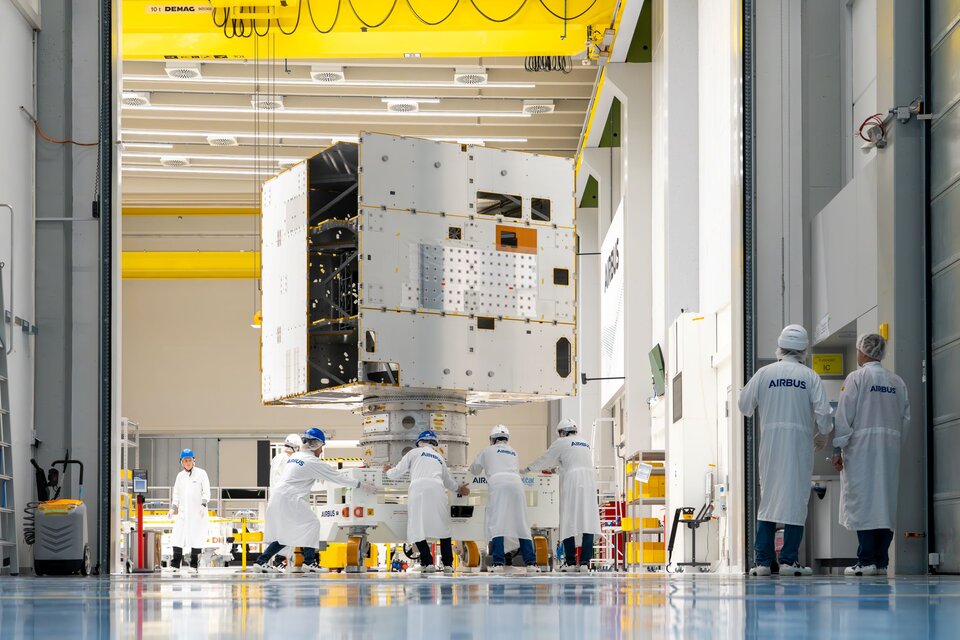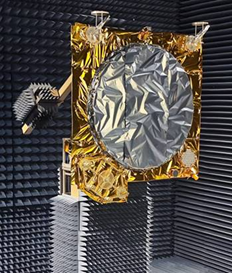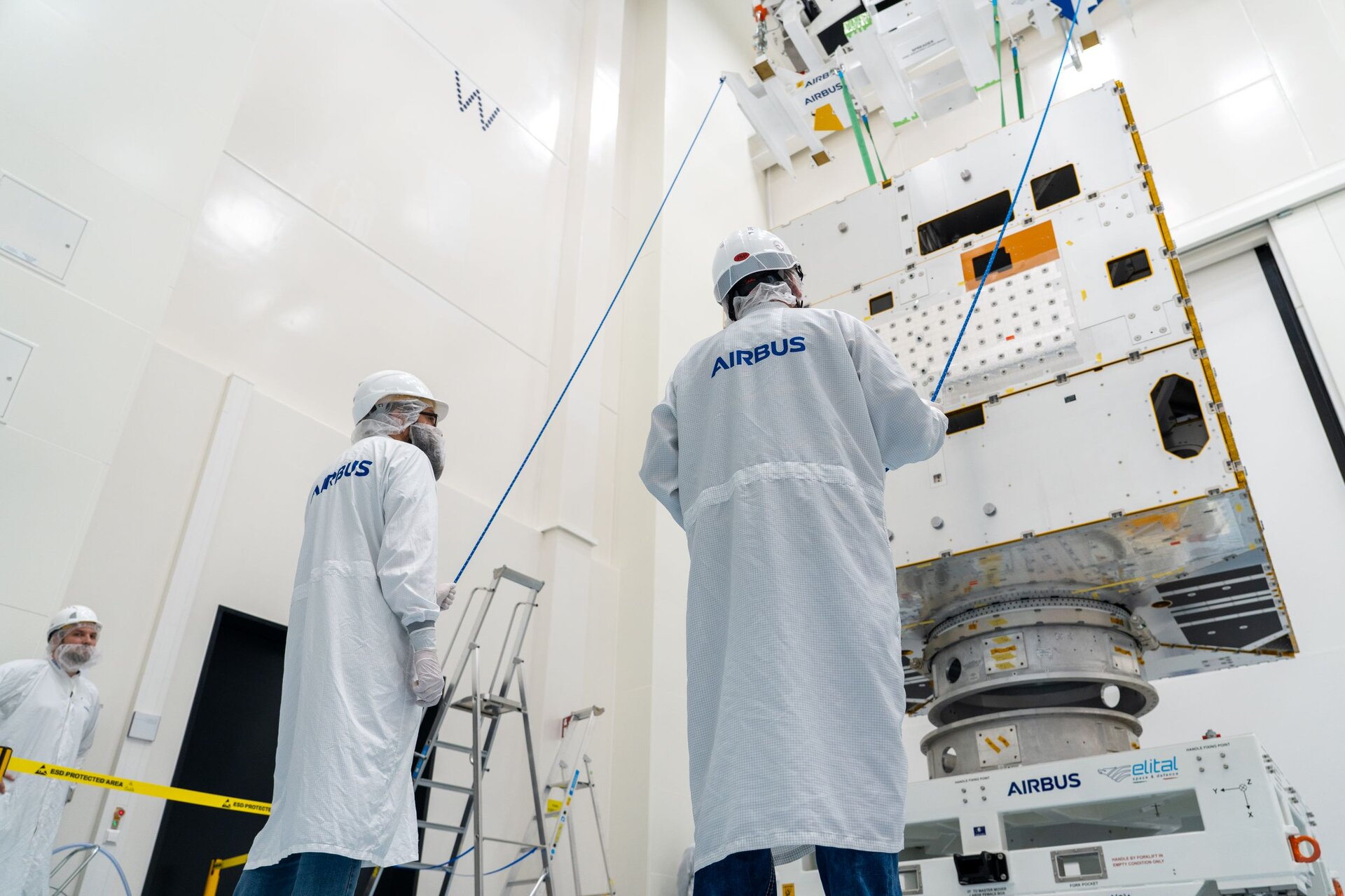Galileo Second Generation satellites take shape
To make the future of Galileo a reality, ESA and European industry are hard at work developing ultra-precise atomic clocks, system testbeds, ground mission and ground control segments and, of course, the satellites. Airbus Defence and Space, who is building six of the Galileo Second Generation constellation satellites, presented their first flight model structure to the programme’s stakeholders last week.
With 28 satellites in orbit and 10 more ready to be launched, Europe’s Galileo is the world’s most precise satellite navigation system. It is used by more than four billion users around the world, who can determine their position at metre-level accuracy.
But Galileo is not stopping here: its Second Generation (G2) is poised to transform the fleet, introducing an array of advanced functionalities and capabilities. "G2 will take our high-performing navigation system into the future with novel services and additional robustness," declares ESA’s Head of Galileo Space Segment Management Office, Andrea Cotellessa.
To make the future of Galileo a reality, ESA and European industry are hard at work developing ultra-precise atomic clocks, system testbeds, ground mission and ground control segments and, of course, the satellites that will make up the constellation. Airbus Defence and Space (DE) and Thales Alenia Space (IT) are building six satellites each that together will form the first G2 fleet.

Galileo Second Generation satellites will be groundbreaking: “they will have fully digital payloads, use electric propulsion, host a more powerful navigation antenna, and carry more and even better atomic clocks on board,” explains ESA's Galileo Second Generation Project Manager Miguel Manteiga Bautista. “The modular architecture will offer a high degree of flexibility to accommodate more equipment and inter-satellite links will be enabled,” he adds.
This innovative design is possible thanks to the dedication of European industry and ESA, who redefine the boundaries of satellite navigation by continuously developing and testing new technologies. In fact, most innovations on G2 satellites stem from R&D programmes like the Agency’s GNSS Evolution Programme and the EU’s Horizon 2020.
Navigation payload and antenna, check

One of the most innovative elements in the Airbus Defence and Space G2 satellite is the navigation antenna, which was validated after undergoing an intensive radiated performance test at the Spanish National Institute of Aerospace Technology (INTA) this summer.
The navigation payload - the satellite’s heart and brain – was assessed at the company's facilities in Ottobrunn, Germany. A model of the payload demonstrated its capacity to amplify and radiate navigation signals as expected.
“After the successful design phase we are now kicking off production in earnest of the state-of-the-art Galileo G2 satellites. Our teams in Friedrichshafen are working with engineers across Europe to meet the challenging schedule and finalise these sophisticated satellites which will further improve the global Galileo system opening up even more opportunities for services on Earth,” said Jean-Marc Nasr, Head of Airbus Space Systems at Airbus Defence and Space.
Flight model satellite structure, check
The G2 satellite structure manufactured by the Swiss branch of Beyond Gravity was presented last week to programme stakeholders at Airbus Defence and Space's site in Friedrichshafen, Germany. “The team demonstrated how the immense panels that form the satellite’s structure will be disassembled and prepared for delivery to the various Airbus sites,” explained Eric Villette, ESA’s Head of Management Office for Airbus Defence and Space G2 Satellite.
The company is reusing a time-tried modular design created for telecommunication satellites. The different units are assembled around a central tube and supported by an outside frame, forming a cube that measures 3 by 3 meters.
In the coming months, the structure will be disassembled and equipped with the harness (the intricate network of wires needed to power and connect the satellite’s components) and the thermal hardware (the system that regulates the satellite’s temperature). Then it will be populated with units, tested for functional and environment verification, and finally qualified for launch.
“The milestones in the development of Galileo Second Generation keep piling up. I cannot wait to see the many parts come together to bring to life an even better performing Galileo system, so this EU programme can continue serving European and world citizens,” says ESA's Director of Navigation Javier Benedicto.
About Galileo
Galileo is currently the world’s most precise satellite navigation system, serving close to four billion users around the globe since entering Open Service in 2017. All smartphones sold in the European Single Market are now guaranteed Galileo-enabled. In addition, Galileo is making a difference across the fields of rail, maritime, agriculture, financial timing services and rescue operations.
Galileo is a flagship programme of the European Union, managed and funded by the European Commission. Since its inception, ESA leads the design, development and qualification of the space and ground systems, as well as procuring launches. The EU Agency for the Space Programme (EUSPA) acts as the service provider of Galileo, overseeing the market and application needs and closing the loop with users.
For more info about Galileo: https://www.usegalileo.eu/EN/


